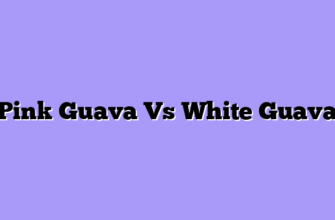The cherry guava, scientifically known as *Psidium cattleianum*, is a small, tropical fruit native to the Caribbean and South America. It is a close relative of the common guava, but with a distinct, sweet-tart flavor and a vibrant red flesh. While enjoyed for its unique taste, the cherry guava also boasts a wealth of health benefits, making it a valuable addition to a balanced diet.
The Health Benefits of Cherry Guava
One of the most notable benefits of the cherry guava is its high vitamin C content. This potent antioxidant plays a crucial role in boosting the immune system, protecting against free radical damage, and promoting collagen production for healthy skin. A single cherry guava can provide a significant portion of the daily recommended intake of vitamin C, making it an excellent source for this essential nutrient.

The cherry guava’s high fiber content also contributes to its ability to support digestive health. Fiber acts as a prebiotic, promoting the growth of beneficial bacteria in the gut, which are essential for optimal digestion and overall gut health. This, in turn, can help prevent digestive issues such as constipation and diarrhea.
Furthermore, the cherry guava has been linked to several other health benefits. Its antioxidant properties may help protect against chronic diseases such as heart disease and cancer. The fruit’s high potassium content can also help lower blood pressure, reducing the risk of cardiovascular disease.
While the cherry guava is a nutritious and delicious fruit, it is important to note that it may not be suitable for everyone. Individuals with allergies to other fruits in the guava family, such as the common guava, may also be allergic to the cherry guava. Additionally, those with kidney problems should consult with a healthcare professional before consuming large quantities of the fruit, as its high potassium content could potentially exacerbate existing conditions.
How to Grow Cherry Guava Trees
- The first step in growing a cherry guava tree is to choose the right location. These trees thrive in warm, sunny climates and prefer well-drained soil. They can tolerate some shade, but they will produce more fruit in full sun. Once you have chosen a suitable spot, you can plant your cherry guava tree. It is best to plant the tree during the spring or early summer, when the weather is warm and the soil is moist. Dig a hole that is twice as wide and as deep as the root ball of the tree. Gently loosen the roots and place the tree in the hole, ensuring that the top of the root ball is level with the ground. Backfill the hole with soil, firming it gently around the roots. Water the tree thoroughly after planting.
- Regular watering is crucial for the establishment of your cherry guava tree. During the first year, water the tree deeply every week, especially during dry periods. As the tree matures, it will become more drought-tolerant, but it will still benefit from regular watering, particularly during periods of hot, dry weather.
- Fertilizing your cherry guava tree is also important for its growth and fruit production. Apply a balanced fertilizer, such as 10-10-10, to the soil around the base of the tree in the spring. You can also use a slow-release fertilizer, which will provide nutrients to the tree over a longer period.
- Pruning is another important aspect of cherry guava tree care. Pruning helps to shape the tree, remove dead or diseased branches, and encourage fruit production. The best time to prune your cherry guava tree is in the late winter or early spring, before new growth begins. You can prune the tree to maintain its desired shape or to remove any branches that are growing too close together or are crossing.
- Cherry guava trees are relatively pest- and disease-resistant. However, they can be susceptible to certain pests, such as scale insects and mealybugs. If you notice any signs of pests, you can treat them with insecticidal soap or horticultural oil.
- With proper care, your cherry guava tree will reward you with an abundance of delicious fruit. The fruits typically ripen in the late summer or early fall and have a sweet, slightly tart flavor. They can be eaten fresh, added to smoothies, or used to make jams, jellies, and even wine.
Delicious Cherry Guava Recipes
One of the simplest ways to enjoy the cherry guava is in its raw form. Its juicy flesh can be eaten directly, offering a refreshing and tangy snack. However, the cherry guava’s versatility extends far beyond simple consumption. It can be incorporated into a wide range of recipes, adding a unique twist to both sweet and savory dishes.
For those seeking a refreshing beverage, a cherry guava juice is a delightful option. The juice can be made by blending the fruit with water and straining it to remove any seeds. For a more complex flavor profile, a touch of lime juice or a hint of honey can be added. This vibrant juice is perfect for a hot summer day, offering a burst of flavor and a refreshing respite from the heat.
The cherry guava’s sweetness also makes it an ideal ingredient for desserts. It can be used to create jams, jellies, and chutneys, adding a unique tang to these classic condiments. The fruit’s vibrant color also makes it an attractive addition to cakes, pies, and tarts. A cherry guava pie, for instance, offers a delightful combination of sweet and tart flavors, with the guava’s unique aroma adding an extra layer of complexity.
Beyond its use in desserts, the cherry guava can also be incorporated into savory dishes. Its tartness complements the richness of meats and poultry, making it an ideal ingredient for sauces and marinades. A cherry guava sauce, for example, can be used to glaze grilled chicken or pork, adding a touch of sweetness and acidity that balances the savory flavors.
The cherry guava’s versatility extends beyond its culinary uses. Its leaves are known for their medicinal properties, and are often used in traditional medicine to treat a variety of ailments. The leaves can be brewed into a tea, which is believed to have anti-inflammatory and antioxidant properties.
Cherry Guava vs. Regular Guava: What’s the Difference?
The most obvious difference lies in their size. As its name suggests, the cherry guava is significantly smaller than the regular guava, resembling a cherry in both size and shape. This diminutive fruit typically measures around 1-2 inches in diameter, while the regular guava can grow up to 4 inches. This size disparity also affects their weight, with cherry guavas weighing in at a mere 1-2 ounces, compared to the regular guava’s 4-8 ounces.
Beyond size, the two guavas exhibit differences in their appearance. The cherry guava’s skin is smooth and glossy, often displaying a vibrant red hue, while the regular guava’s skin can be rougher and range in color from green to yellow. The flesh of the cherry guava is also distinct, boasting a bright red color that contrasts with the pale white or yellow flesh of the regular guava.
These visual differences are accompanied by variations in taste and texture. The cherry guava, despite its small size, packs a punch of flavor. Its flesh is juicy and sweet, with a hint of tartness that adds complexity to its taste profile. In contrast, the regular guava has a milder flavor, with a softer texture that can be slightly mealy.
The differences in taste and texture also translate to their culinary uses. Cherry guavas, due to their intense flavor and small size, are often enjoyed fresh, adding a burst of sweetness to salads or desserts. They can also be used to make jams, jellies, and sauces. Regular guavas, on the other hand, are more versatile, being used in both sweet and savory dishes. They can be eaten fresh, juiced, or incorporated into smoothies, pies, and even curries.
While both cherry and regular guavas offer unique flavors and textures, their nutritional profiles are remarkably similar. Both are rich in vitamin C, a powerful antioxidant that supports immune function. They are also good sources of dietary fiber, which aids in digestion, and potassium, an essential mineral for maintaining healthy blood pressure.
The History and Origin of Cherry Guava
The cherry guava’s journey across the globe is a testament to its adaptability and resilience. It thrives in a variety of climates and soil conditions, making it a popular fruit tree in many parts of the world. Its small size and ease of cultivation also contributed to its widespread adoption. Early European explorers and colonists were likely responsible for introducing the cherry guava to new regions. They recognized its potential as a food source and a valuable commodity, and they carried its seeds and seedlings with them as they traveled.
The cherry guava’s journey to Asia is particularly interesting. It is believed to have been introduced to Southeast Asia by Portuguese traders in the 16th century. From there, it spread to other parts of Asia, including India, China, and Japan. The cherry guava’s arrival in Asia coincided with a period of intense trade and cultural exchange, and it quickly became a popular fruit in many Asian countries.
Today, the cherry guava is cultivated in numerous countries around the world, including Brazil, India, China, Australia, and the United States. It is a popular fruit for its sweet, slightly tart flavor and its versatility in culinary applications. The cherry guava can be eaten fresh, used in jams and jellies, or processed into juices and other beverages. Its leaves are also used in traditional medicine for their purported health benefits.
The cherry guava’s history is a fascinating story of human interaction with the natural world. It is a testament to the power of trade, migration, and cultural exchange to shape the distribution and cultivation of plants around the globe. As a result of these forces, the cherry guava has become a beloved fruit in many parts of the world, enjoyed for its unique flavor and its numerous culinary and medicinal uses.
Q&A
1. What is a Cherry Guava?
A cherry guava is a small, round fruit with a sweet, slightly tart flavor. It is a hybrid of the common guava and the strawberry guava.
2. Where does Cherry Guava grow?
Cherry guava is native to the Caribbean and is now cultivated in many tropical and subtropical regions.
3. What does Cherry Guava taste like?
Cherry guava has a sweet, slightly tart flavor with a hint of strawberry. The flesh is soft and juicy.
4. What are the health benefits of Cherry Guava?
Cherry guava is a good source of vitamin C, fiber, and antioxidants. It may also help boost the immune system and improve digestion.
5. How can I eat Cherry Guava?
Cherry guava can be eaten fresh, added to smoothies, or used in jams, jellies, and desserts.









I think it would be wise to include facts about how very invasive this plant is to places like Hawaii where it is the most invasive plant. It is Allelopathic and will curb the growth of native fauna in many locations because of this. Also, many animals enjoy these fruits so they will scatter the seeds in their waste as the seeds are very hard and tough, withstanding the stomach acids. I wish you would not encourage it’s cultivation in places it is not native.